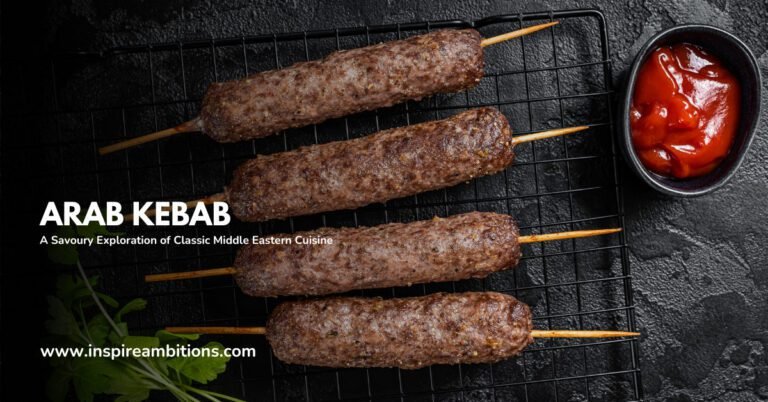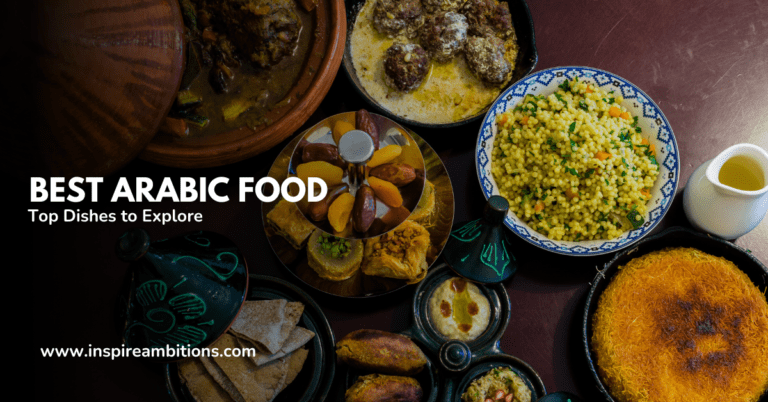Pan árabe: revelando la rica historia y las variedades de la cocina de Oriente Medio
Bread is a staple food around the world, and Arabic bread is no exception. Across the Middle East, various types of bread are enjoyed as part of everyday meals. One of the most popular types is khubz, also known as khabaz, a kind of flatbread that often accompanies traditional Arabic dishes.
You might be familiar with pita bread, which is a type of pocket bread commonly consumed in the Levant and Egypt. Another well-known pan arabe is the tannur bread, a flatbread that’s especially popular in Iraq.
No matter where you are in the Middle East, you’re likely to encounter a wide variety of delicious and nutritious breads that have been favoured for centuries.
History of Arabic Bread
In the history of bread, Arabic bread holds a prominent position. The ancient civilisations of the Middle East, such as the Sumerians, Babylonians, Phoenicians, Hittites, Arameans, Assyrians, Egyptians, and Nabateans, contributed to the development of Arabic bread.
In the Arabic language, bread is commonly referred to as ‘Khubz’ or ‘Khoubz.’
One of the oldest examples of Arabic bread is the traditional Shrak or Markook flatbread, which has been prepared at home for centuries. It is extremely popular in the Levant and the Arabian Peninsula. Formed by mixing cereal and grain flour with water, the obtained dough would then be baked over a fire.
This process has stood the test of time, and to this day, pan arabe remains a staple in many homes across the Middle East.
Another variety of Arabic bread that has ancient roots is Pita, also known as Arabic bread, Syrian bread, or pocket bread.
Pita is a yeast-leavened flatbread which can be found throughout the Middle East and neighbouring regions. Its history goes back thousands of years and is closely linked to the rich culture of the region.
Today, Arabic bread continues to be an important part of the daily diet in the Middle East, and its various forms can be found in a multitude of recipes and settings.
While the preparation techniques have evolved with the advent of modern cooking equipment, its basic ingredients and methods remain true to their roots. Thanks to its versatility and easy-to-make nature, Arabic bread has gained popularity and can be enjoyed by people all over the world.
Variaciones regionales
Learn about Arabic bread in different regional settings.
Líbano
In Lebanon, you might come across a popular type of bread called ‘manakish.’ This flatbread is made with a soft and slightly chewy dough base, which is often topped with a mix of za’atar (a blend of herbs, sesame seeds, and oil), cheese, or meat.
The manakish is typically served for breakfast or a light lunch, and it is best enjoyed fresh out of the oven at a local bakery or comida de la calle stall.
Siria
Syrian bread is known for its thin and soft texture. The most well-known of these bread is the ‘markouk,’ which is a large and extremely thin flatbread. Markouk is often cooked on a dome-shaped griddle called a ‘saj,’ which gives it its characteristic texture and appearance.
The bread is commonly used for wrapping various fillings such as kebabs, vegetables, or hummus, making it a versatile addition to your Syrian meal.
Egipto
Egyptian bread, also known as ‘eish baladi,’ is a small, round, and slightly thicker flatbread made from whole wheat flour. It is a staple in Egyptian households and is often served with various dips, spreads, and salads.
Be sure not to miss out on ‘feteer meshaltet,’ another type of Egyptian bread. It is multi-layered, flaky, and can be served with both sweet and savoury fillings, offering you versatility in your culinary experience.
Arabia Saudita
In Saudi Arabia, ‘khubz’ is the most common type of bread. It is similar to pita bread and features a round shape and a pocket, perfect for stuffing with various ingredients like shawarma, falafel or salads.
Another notable bread in Saudi Arabia is the ‘mamoul,’ a sweet pastry filled with dates or sesame paste. Although this may not be a traditional bread like the others mentioned, it is still a beloved dessert option that showcases the region’s diverse flavours.
Ingredients Used in Arabic Bread
Arabic bread, also known as pita bread or Khobz Arabi, is a staple in Middle Eastern cuisine. It is made with just a few simple ingredients, making it an easy and delicious addition to your meals. In this section, we will discuss the key ingredients used in the preparation of Arabic bread.
Harina:
The main ingredient in Arabic bread is strong white bread flour that provides the structure needed for the bread to be soft yet sturdy. You can use 300g of strong white bread flour for a basic recipe. Remember to sift the flour before using it to ensure a smooth and even dough.
Levadura:
Using yeast in Arabic bread ensures that it has the desired light and airy texture. Active dry yeast is the preferred choice for this kind of bread. For a standard recipe, around 2 teaspoons of active dry yeast should be sufficient.
Agua:
Warm water is essential for activating the yeast and dissolving sugar in the dough. Use lukewarm water for the best results. The quantity of water can vary depending on the desired consistency of your dough, but approximately one cup would be adequate.
Sugar and Salt:
Sugar helps activate the yeast and adds a subtle sweetness to the bread, while salt enhances the overall flavour and balances the taste. These ingredients are generally used in small quantities, around 1 teaspoon of sugar and 1/2 teaspoon of sea salt.
Olive Oil:
Olive oil is often incorporated into the dough, lending a subtle flavour and texture to the bread. Typically, 4 tablespoons of olive oil would be sufficient for a basic recipe. However, you can adjust this quantity according to your preference.
In summary, the main ingredients used in Arabic bread are strong white bread flour, active dry yeast, warm water, sugar, salt, and olive oil.
By combining these ingredients in the correct proportions and following the appropriate method, you can create a delicious and authentic Arabic bread to enjoy with various Middle Eastern dishes.
Métodos de preparación
When preparing Arabic bread, you’ll begin with some essential ingredients, such as flour, salt, sugar, oil, and yeast. Begin by sifting the flour into a mixing bowl, then add the salt and sugar. Pour in the oil and mix well with your hands.
In a separate container, dissolve the yeast in lukewarm water and gradually add it to the flour and oil mixture, combining it with your hands until a ball is formed.
There are various methods for preparing Arabic bread, and each method results in a unique texture and taste. One popular method involves spreading a thin sheet of dough on a heated metal surface.
Saj bread, also known as Markook or Shrak bread, is prepared by cooking dough on a domed or convex metal griddle, called Saj. Another type of Arabic bread, Taboon bread, is named after the Taboon oven in which it’s baked.
When making Khubz Tannour, transfer the dough to a very large bowl and smooth the surface with wet hands. Cover the bowl and let the dough rise in a warm, draft-free place for about 45 minutes.
Midway through the rising time, punch and knead the dough lightly with both wet hands. Then, preheat your oven to 230°C (450°F) before baking.
For Khobz Arabi, mix the dough ingredients until it resembles a thick batter, and set aside for 20 minutes.
In the meantime, combine water, active dry yeast, and granulated sugar in a small bowl, stirring until foamy, which takes about 10 minutes. Next, you’ll mix these two parts to create the dough for this Arab flatbread.
Remember that the key to delicious and authentic Arabic bread is mastering the various preparation methods, and cooking techniques, and using the right ingredients. Once you become familiar with these, you’ll be able to enjoy an array of delicious Arabic breads in your kitchen.
Nutritional Value
Arabic bread, also known as pita bread, is a staple in Middle Eastern cuisine. Understanding its nutritional value can help you incorporate it into a balanced diet.
en un 100g serving of Arabic bread, you will find approximately 286 calories. The primary source of these calories comes from carbohydrates, with around 60g present. It’s worth noting that this healthy source of energy is essential for fuelling your body’s daily activities.
Moving on to protein, Arabic bread contains around 10g per 100g serving. This macronutrient is essential for tissue repair and muscle building, making it a vital component of your daily intake.
When it comes to fat content, you’ll be pleased to know that Arabic bread is quite low in fat, containing only about 0.1 g per 100g serving. As a result, it can be a suitable option for those watching their fat intake.
Regarding dietary fibre, Arabic bread provides about 30 milligrams. Fibre is vital for promoting digestion and maintaining a healthy gut, so including it in your diet is important.
Lastly, Arabic bread has a sodium content of around 250 milligrams per 100g serving. Monitoring your sodium intake is crucial for maintaining healthy blood pressure, so keep this number in mind when planning the rest of your meals for the day.
Overall, Arabic bread can be a nutritious and delicious addition to your diet. By being mindful of portion sizes and pairing it with other nutrient-dense foods, you can reap the benefits of this Middle Eastern staple.
Relevancia cultural
Bread holds an essential place in Arabic culture, often being present at every meal and considered a symbol of hospitalidad. It is not just a food item, but also an important element in Arabic expressions, proverbs, and customs.
In the Arab world, bread carries a deep meaning of unity and togetherness. Sharing bread is a way of forging bonds, expressing trust, and showing respect. This is because bread is a staple food in many Middle Eastern countries, providing sustenance and nourishment to people of all backgrounds.
One popular type of Arabic bread is khubz, commonly found in various forms across the region. This versatile bread is often used as an edible utensil in meals, with diners tearing off pieces to scoop up food.
It is also served alongside dips, such as hummus and baba ghanoush. The preparation and baking of khubz, especially using traditional tannour ovens, symbolise the connection between present-day food culture and ancient culinary traditions.
Another type of bread, known as ka’ak, resembles a dry, hardened biscuit that is mostly ring-shaped.
It can be found at celebrations and events, offering a more festive aspect of Arabic bread culture. The practice of making and sharing bread in these settings further highlights its role as a cherished component of Arab life.
To sum up, Arabic bread holds a significant place in the region’s culinary landscape and cultural practices. From daily sustenance to special occasions, it remains an enduring symbol of unity, sharing, and tradition in the Arab world.
Arabic Bread in Modern Cuisine
Arabic bread, also known as khobz, khubz, or pita, has been a staple food in the Middle East for centuries. In modern cuisine, its versatility and unique taste have made it popular worldwide. In this section, you will explore how Arabic bread has adapted to contemporary culinary trends, to hold its cherished place in today’s gastronomy.
One of the key aspects of Arabic bread’s modern appeal is in fusion cuisine. Culinary artists have experimented with pita to create fusion dishes that blend Arabian and Western flavours. Examples include pita pizzas, pita pocket sandwiches, and even pita croutons for salads.
The availability of Arabic bread has increased, with pre-packaged pita bread now found on supermarket shelves along with traditional bakeries. You can also enjoy a variety of options such as whole wheat, gluten-free, and multi-grain pitas, catering to diverse nutritional preferences and dietary restrictions.
Arabic bread is also an integral part of contemporary Middle Eastern cuisine. The rise of mezze, small plates of appetisers or entrées, has contributed to the increased appreciation for this bread.
Whether you’re dipping it in hummus, baba ganoush, or using it to scoop up tabbouleh, Arabic bread complements the flavours of these dishes perfectly.
In sum, Arabic bread has not only maintained its significance in traditional Middle Eastern cuisine but also adapted to satisfy the diverse tastes of modern culinary enthusiasts. From fusion dishes to nutritious options, and from supermarkets to mezze, Arabic bread has proven its enduring appeal.







